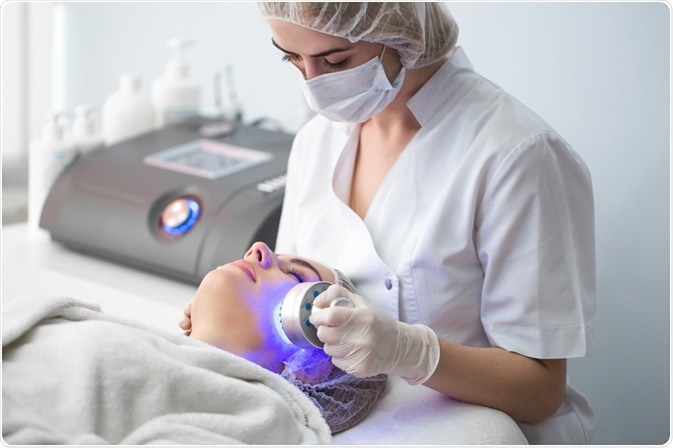The history of light therapy dates back more than 3,000 years ago in India, where sunlight was used for therapeutic purposes and recorded in the sacred Hindu texts. Today, the beneficial effects of light therapy are well-established and they involve the use of visible light or non-visible ultraviolet (UV) light to treat a myriad of conditions.
Conventional light sources include incandescent lamps, fluorescent lamps and electric ares. Light therapy boxes that emanate full-spectrum light similar in composition to sunlight are also often employed. Identifying the individual circadian rhythm and selection of proper timing is critical for adequate administration of light therapy.

Image Credit: Studio Peace / Shutterstock.com
The rationale behind light therapy
Two inherent properties define the biological grounds of light therapy, which is also known as phototherapy, which include wavelength and intensity. The wavelength range of visible light is roughly between 780 nm (red end) to 400 nm (violet end). The circadian rhythm, which is often referred to as the body's natural clock, represents a 24-hour cycle that regulates sleep and other physiological processes.
In the past, researchers often utilized bright white light, which is a mixed spectrum of wavelengths that imitate daylight, in order to study light effects on human circadian rhythm. On the other hand, recent studies have demonstrated better effectiveness of short-wavelength blue light, which is approximately 460 nm, with better phase-shifting properties when compared to the rest of the visible light spectrum.
Light therapy targets the subjective human biological clock and attempts to reset the phase of the clock's activity, relative to the cycles of light and dark. Thus, common goals of light therapy are to synchronize the sleep-wake cycle with the subjective night, to facilitate sleep at the desired time of day or night, and to attain indirect effects on the mood of a patient.
Photodynamic therapy (or PDT) is a special kind of light therapy that uses drugs called photosensitizing agents along with light in order to kill cancer cells. It can also aid traditional light therapy in shrinking sebaceous glands. These drugs only work after they have been activated by certain kinds of light. In medical literature, the procedure is also known as phototherapy, photoradiation therapy, or photochemotherapy.
Application in clinical practice
In psychiatry and neurology, light therapy has been extensively used to treat a wide range of disorders that are usually classified into three broad categories. These include disorders caused by desynchronization between the body's circadian rhythm and the external environment, mood disorders, and disorders that contain elements of both.
Phototherapy with visible light, specifically blue light, has been shown to improve skin conditions in cases of acne and blemishes. Upon reaching the sebaceous glands in the skin, blue light successfully excites porphyrins, which are compounds produced by bacteria that cause acne (namely of the genus Propionibacterium). When they are activated by light, porphyrins can destroy the bacteria from the inside out.
Neonatal jaundice represents the yellowing of the skin as a result of increased levels of total bilirubin in infants. Blue-light phototherapy is the treatment of choice for otherwise healthy newborn children with elevated unconjugated bilirubin.
Photodynamic therapy has played a significant role in the treatment of dermatological diseases such as actinic keratinosis, various cutaneous lesions, and non-melanoma skin cancer. Furthermore, applications of this type of treatment have been used in cases of periodontal diseases, oral leukoplakia, oral cancer, macular degeneration, and a panoply of solid tumors from diverse tissues and organ systems.
Low-intensity light therapy (LILT) is becoming a promising tool in the treatment of a wide variety of conditions, such as arthritic pain, delayed wound healing, and acute stroke. Improvements in these conditions have been attributed to the rapid elevation of ATP, increased angiogenesis, anti-apoptotic activity, as well as a surge in heat shock proteins and total antioxidants.
References
Further Reading